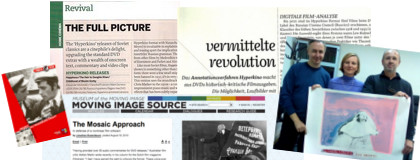
Towards a Typology of the DVD Commentary in the Context of Scholarly Film editions (March/June 2007). |
|
More than two decades ago, in the era of laser discs, the first commentaries which were on the same medium or format as the film itself emerged. They were looked upon not only as an exciting “extra“ but also as a new opportunity for film studies. With the advent of DVD these commentaries, formerly considered as a part of a niche product, started becoming more and more popular and widespread and came to be look upon as a marketing tool.
The second type is a written commentary (text screens). Mostly this is a free standing text, graphically presented on a DVD, accessible from a sub-menue, detached from the film proper. This type is often used when the films commented upon are rather short (e.g. early films as on the DVD More treasures from American Film Archives. 1894-1931, NFPF 2004); a written commentary of that type provides also a possibility to supply quotes from texts not especially produced for the DVD (mostly by the director or from reviews). This type - although it can appear on the screen - is not much different from a short text in a booklet (often it is also reproduced on paper).
There is another possibility to present commentaries on a DVD which would not be confined by the linearity of the film but still connected to the film without directly influencing the viewing experience. This commentary would be based on the principles of hypertext and linking the annotation directly to the film shots commented upon. This means that the first step in preparing such an edition of a film would be to go back to the very making of the film, its smallest units. By subdividing the film into smaller portions (shots and/or sequences) it becomes easily indexable; as a result the film scholar has easy access to the montage structure of the film which can been laid out graphically. Some of the shots will be linked to the commentary units (“footnotes“) which can comprise all media (written word, audio, video, photo etc.). If the viewer decides to watch the film in the hyperlinked mode he can “click“ on a button which will lead him to the “footnote“ – in the meantime the film pauses so that the viewer will return to the same point when leaving the “footnote“.
What are possible weaknesses of this method? Television screens cannot cope with large amounts of text. It is true that the hyperkino system encourages the viewer to insert the DVD into the computer; this makes the text screens much easier to read and the computer encourages the viewer to develop an interactive approach. A hyperkino DVD needs to be used interactively – it is more than just watching the film. Maybe we don't need to simulate the movie theater situation when watching a DVD but rather we should take the opportunities the DVD format provide seriously, in presenting the film and additional materials. This does not alter the possibility to watch the same DVD in the only-film mode from the same DVD!
This outline might have shown which commentaries can do what in film studies. It also shows how film scholars could be involved in future academic film editions on DVD – that is not as guests of DVD Publishers but as editors, responsible for the scholarly content on the DVD and the selection of the material presented.
The project of “Hypertextual Film Presentation, Designing Digital Editions for the European Cinematographic Heritage" (2006-8) is being supported by the European Community's Sixth Framework Programm with a Marie-Curie Fellowship ____________________________________________________ [1] Wikipedia supplies a threefold typology of audio commentaries (“edited“, that is “recorded at various sessions, often with various speakers“, “character, which features one or more actors commenting on the movie while in character“ and “scholarly, which is performed by a film critic, historian or scholar, taking the viewer through the significance of the film, the technique, and at times telling the story behind its making. Variations feature fans who would also have some level of expertise concerning a title.“) http://en.wikipedia.org/wiki/Audio_commentary_(DVD). This typology doesnt work: There are scholarly edited commentaries like the BFI commentary for the DVD The Edge of the World which combines the voices film editor and the widow of the director Thelma Schoonemaker, of the actor Daniel Day-Lewis and of Ian Christie, a scholar (http://www.bfi.org.uk/booksvideo/video/details/edgeoftheworld/). [2] Cf. the following (unassigned;-) claim about the rejection of audio tracks overlaying a movie by a director: “Despite his high profile, director Steven Spielberg has yet to provide a commentary track for any of his films. He feels that the experience of watching a film with anything other than his intended soundtrack detracts from what he has created. http://en.wikipedia.org/wiki/Audio_commentary_(DVD). Another director who does not do audio commentaries is David Lynch. |
|
